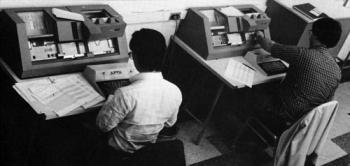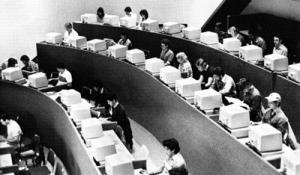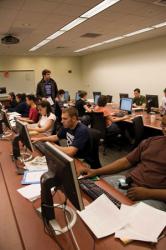Then and Now: Computing on Campus
From mainframes to Macs, computing on campus has changed dramatically over the years. Here is an unapologetically incomplete look back at some of the developments.

Keypunch machines on campus in the late 1970s.

From mainframes to Macs, computing on campus has changed too dramatically over the years to give a comprehensive look back on this page. What follows, therefore, is an unapologetically incomplete review of some events that helped shape the campus’s computing landscape.
“It all started with punch cards and the mainframe,” Professor Ed Conjura said about computing on campus. He should know: he founded the College’s computer science department, nursing it from its infancy as a few course offerings within the math department, to its own specialized track within a renamed Department of Mathematics and Computer Science, to a degree-granting major and department unto itself.
Carol Allen Spitz ’84 was a student here while the computer science program was a track within the math department. She recalled what computing on campus was like in the early 1980s.
“You keypunched your program, one line per card, onto punch cards using machines in the Green Hall basement,” Spitz explained. “There were about 12 machines in Green at the time, and you’d have to wait in line for one of the machines to be open.” Once done, “You put your cards in a card reader, and the program would run in the back on an IBM. Then someone in the back would print out your results and put them in a bin, arranged alphabetically, where you’d pick up your program,” she said. The process could take hours—possibly days—both Spitz and Conjura said.
(It’s worth noting that this several-hour turnaround time was an improvement from the late 1960s, when Professor Emerita Jane Ann McLaughlin used the computer in Green Hall to complete the FORTRAN course work she was taking as part of her doctoral studies. “The turnaround time then was one week,” McLaughlin said. “As I remember, that semester was sort of a nightmare once in awhile!”)
Another possible time-killer in the days of punch card computing was the possibility of dropping your stack cards while hurrying to class. “There was always at least one student that happened to,” Biagio Sabatino ’85, one of the first graduates of the computer science major, remembered. You could often spot the student unlucky enough to befall such a fate, as they were the ones frantically trying to rearrange their program cards at the beginning of each class.
Both Sabatino and Spitz remembered taking classes in BASIC, Fortran, PL1, and Assembly Language programming while students. Pat Carney ’84 recalled that students interested in computing could also take COBOL classes through the School of Business. He also remembered taking a class in “an innovative new programming language [that] was so new it was not yet accepted in the business world: C. It was more cryptic but certainly sexier than COBOL,” he added.
“Of course, C has [since] been widely accepted and [is] the basis of many successful applications,” Carney said, before adding, “But for that one semester, writing programs in C, I was a ground-breaker!” he joked.
The class that sticks out in Sabatino’s mind was “Software Development to the 1023 Seconds of the Universe,” taught by the late Charles Goldberg. “That class was probably the craziest course I took,” Sabatino said.
“Dr. Goldberg would give us a floppy and a hexadecimal keyboard that let you type 0 through 9 and A through F,” Sabatino explained. “The ‘break’ key executed a jump instruction. Then Dr. Goldberg would break the PC’s bootstrap program and tell us we had to take the items in hand and make it into a working computer – one that you could write a program on, save it, and print it.”
“Pretend you’re in the lunar lander, the computer just crashed, and you’re the computer scientist on the mission,” Goldberg would tell his students. “You’ve got to get that computer up and running or you’re all going to die.”
Goldberg was reminding his students that they were getting a degree in computer science, and that they needed to understand what was happening underneath the many layers of software that came preloaded on computers, Sabatino explained.

Spitz, Sabatino, and Carney witnessed tremendous change while students here. Mainframe computing gave way to minicomputers, which gave way to PCs. Sabatino remembers setting up the first PC lab, which featured IBM PC XT machines with “64 KB of RAM and dual 5.25” floppy disk drives—that was about as ‘souped up’ as computers got back then,” he said.
Gradually, more academic disciplines required students to use computers—whether to create art, run a statistical program, control scientific equipment, or simply word-process a term paper. Accordingly, more labs started popping up on campus. Early on, each lab had its own software.
“You went to Holman to work on your computer science assignment, to the library to use the word processors, and to the business building to use business applications,” said Shawn Sivy ’91.
Sivy, who is now TCNJ’s director of networking and technical services, recalled that just because they weren’t working with punch cards any longer, writing and compiling programs could still be a time-consuming exercise.
“It was always fun using the computers in those days,” he joked. “You’d go to compile your program that was supposed to print ‘Hello world!’, you’d walk away for couple of hours, come back, and it might be ready to run. Then you’d have to delete it because there wasn’t enough disk space to keep it around,” Sivy said.
There were no shared drives on which to save your work back then. Jeff Kerswill, who has worked at TCNJ for 19 years and is now director of user support services, remembered that when he arrived on campus, “there were about 50 PCs campus-wide, and everyone stored their data on floppies. I was thrilled to death when [years later] I received a 10 megabyte hard drive,” he said.

There labs were not networked together back then either, Sivy said, which made e-mail a little tricky. “If someone sent you an e-mail from a computer in Holman, you had to use a computer in Holman to read it. If someone sent you an email from Bliss, you had to go to Bliss to read it. Every lab had a separate e-mail server,” he explained.
The early 1990s saw the rise of the Internet, at first only accessible from a single computer in Green Hall. Sivy remembered that, as a student in 1989–90, “you’d have to come to the basement of Green Hall. There was a special Sun computer that you’d have to get all sorts of permission from people just to get on the Internet.”
“You could only get the Internet from that one location on campus,” Sivy continued, “but it had a 56K connection, which was plenty fast enough back then.”
Gradually, throughout the late 1990s, IT started networking the campus and adding more machines so that eventually every professor and staff member that needed a computer had one on his or her desk. Sivy and Kerswill said that, in their estimation, one of the biggest developments that followed the campus computers being networked together was the launch of Software at Any Location (SAL). This enables access to 250+ software applications from any computer in the 30+ computers labs or 130 smart classrooms on campus.
Another change in the campus-computing scene has been the increase in the number of students bringing their own computers to campus with them. Kerswill estimated that nearly 99 percent of students show up to campus with their own computer, and nearly half of them are laptops. Despite that, there is no indication the need for computer labs will go away.
Posted on November 3, 2008

